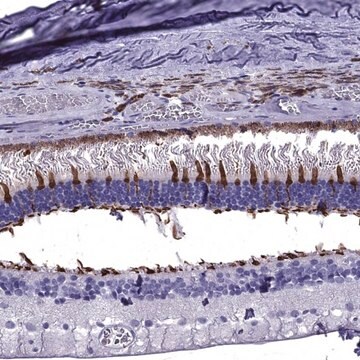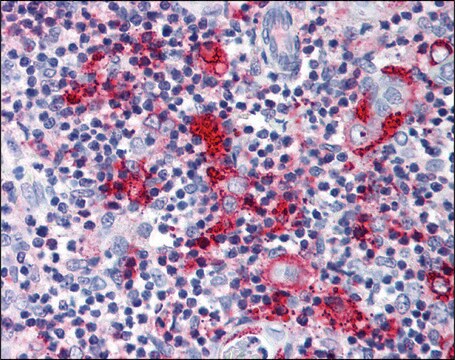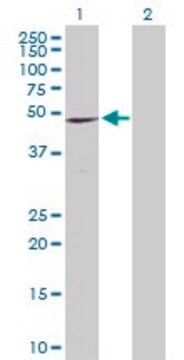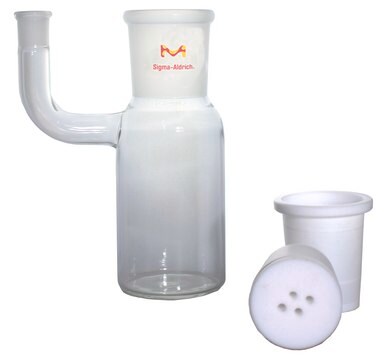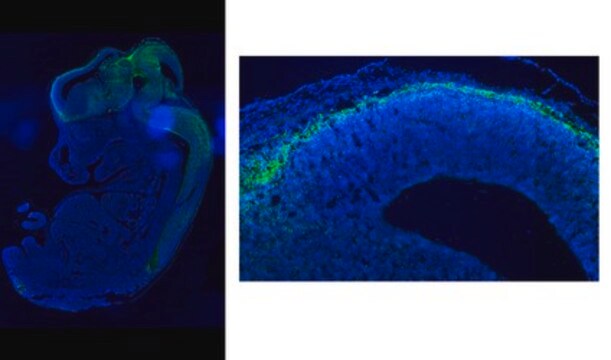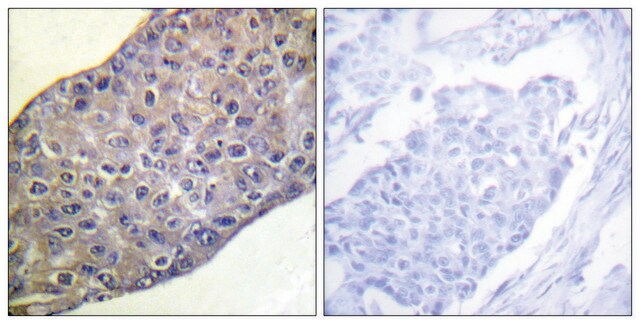MABF2791
Anti-CCR9 Antibody, clone 7E7
Synonim(y):
Receptor chemokiny C-C typu 9; C-C CKR-9; CC-CKR-9; CCR-9; Receptor chemokiny C-C 10; CDw199
About This Item
Polecane produkty
pochodzenie biologiczne
rat
Poziom jakości
białko sprzężone
unconjugated
forma przeciwciała
purified antibody
rodzaj przeciwciała
primary antibodies
klon
7E7, monoclonal
masa cząsteczkowa
calculated mol wt 41.91 kDa
oczyszczone przez
using protein G
reaktywność gatunkowa
mouse, human
opakowanie
antibody small pack of 100 μg
metody
flow cytometry: suitable
immunofluorescence: suitable
immunohistochemistry (formalin-fixed, paraffin-embedded sections): suitable
izotyp
IgG2b
sekwencja epitopowa
N-terminal
numer dostępu Protein ID
numer dostępu UniProt
Warunki transportu
ambient
docelowa modyfikacja potranslacyjna
unmodified
informacje o genach
human ... TACSTD2(4070)
Powiązane kategorie
Opis ogólny
Specyficzność
Immunogen
Zastosowanie
Ocena metodą cytometrii przepływowej w tymocytach myszy BALB/c.
Analiza metodą cytometrii przepływowej: 1 μg tego przeciwciała wykryło CCR9 w milionie tymocytów myszy BALB/c.
Testowane zastosowania
Zastosowania immunohistochemiczne: Reprezentatywna partia wykryła CCR9 w zastosowaniach immunohistochemicznych (Guo, Z., et al. (2008). Int Immunol. 20(3):307-15; Pabst, O., et al. (2004). J Exp Med. 199(3):411-6; McGuire, H.M., et al. (2011). Immunity. 34(4):602-15).
Analiza cytometrii przepływowej: Reprezentatywna partia wykryła CCR9 w zastosowaniach cytometrii przepływowej (Guo, Z., et al. (2008). Int Immunol. 20(3):307-15; Pabst, O., et al. (2004). J Exp Med. 199(3):411-6; McGuire, H.M., et al. (2011). Immunity. 34(4):602-15; Svensson, M., et al. (2008). J Leukoc Biol. 83(1):156-64; Chennupati, V., et al. (2010). J Immunol. 185(9):5160-8).
Analiza immunofluorescencyjna: Reprezentatywna partia wykryła CCR9 w zastosowaniach immunofluorescencji (Guo, Z., et al. (2008). Int Immunol. 20(3):307-15; Pabst, O., et al. (2004). J Exp Med. 199(3):411-6; McGuire, H.M., et al. (2011). Immunity. 34(4):602-15).
Uwaga: Rzeczywiste optymalne rozcieńczenia robocze muszą być określone przez użytkownika końcowego jako próbki, a warunki eksperymentalne mogą się różnić w zależności od użytkownika końcowego.
Postać fizyczna
Przechowywanie i stabilność
Inne uwagi
Oświadczenie o zrzeczeniu się odpowiedzialności
Nie możesz znaleźć właściwego produktu?
Wypróbuj nasz Narzędzie selektora produktów.
Kod klasy składowania
12 - Non Combustible Liquids
Klasa zagrożenia wodnego (WGK)
WGK 1
Certyfikaty analizy (CoA)
Poszukaj Certyfikaty analizy (CoA), wpisując numer partii/serii produktów. Numery serii i partii można znaleźć na etykiecie produktu po słowach „seria” lub „partia”.
Masz już ten produkt?
Dokumenty związane z niedawno zakupionymi produktami zostały zamieszczone w Bibliotece dokumentów.
Nasz zespół naukowców ma doświadczenie we wszystkich obszarach badań, w tym w naukach przyrodniczych, materiałoznawstwie, syntezie chemicznej, chromatografii, analityce i wielu innych dziedzinach.
Skontaktuj się z zespołem ds. pomocy technicznej